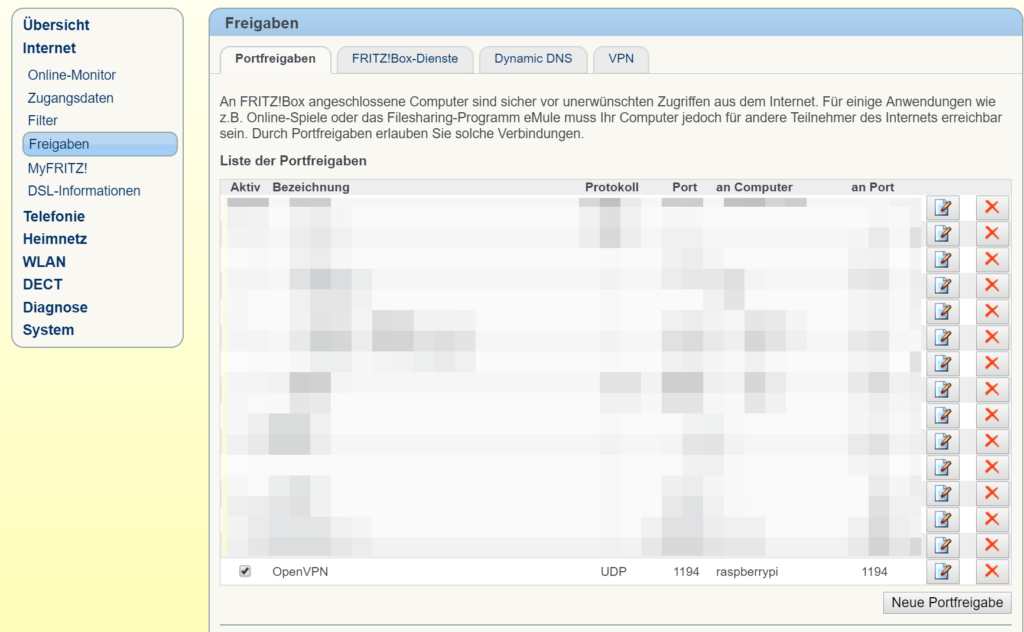OpenVPN Server auf dem Raspberry Pi installieren
Wir zeigen Ihnen wie Sie OpenVPN Server auf dem Raspberry Pi* installieren. Die Installation ist Skript gesteuert. Diese Anleitung funktioniert ebenfalls unter Debian, Ubuntu und CentOS. Das gleich benutzte Skript wird Ihnen beim Aufruf anzeigen, ob es auf Ihrem Linux funktioniert.
Ein VPN Server ist aus mehreren Gründen sinnvoll und auch zu empfehlen. Der wichtigste Grund ist Sicherheit. Wenn man z.B. mit dem Handy in fremden öffentlichen WLAN Netzwerken unterwegs ist, wird der Traffic zusätzlich verschlüsselt und ist gegen das „Lauschen“ gesichert. Zum Anderen lassen sich damit Geo-Blockaden umgehen.
Vorraussetzung:
- Installationsscript ¹https://bit.ly/1LLSCg0
- Putty
- z.B. Raspberry Pi*, Ubuntu etc.
1. Per Terminal auf den Raspberry Pi schalten
Schalten Sie sich mit Putty oder Terminal auf Ihren Raspberry Pi*. Sie benötigen Superrechte.
sudo -i
2. OpenVPN herunterladen
Im Anschluss laden Sie das OpenVPN Script herunter.
wget https://bit.ly/1LLSCg0 -O openvpn-install.sh
3. OpenVPN Skript aufrufen
bash openvpn-install.sh
4. OpenVPN konfiguration
- Geben Sie die IP-Adresse von Ihrem Raspberry-Pi ein. Diese sollte statisch sein.

- Wählen UDP als Protokoll aus. Dazu geben sie die 1 ein.
- Port auf dem OpenVPN reagieren soll. Den Standardport 1194 können sie mit Enter bestätigen.
- Wählen Sie einen DNS-Server aus. Empfehlung: 1
- Anschließend wählen Sie einen frei wählbaren Namen für ein Gerät, das sich auf dem VPN-Server anmelden wird. Beispiel: Handy1
- Installation mit Enter bestätigen. Die Installation dauert einige Minuten.
- Falls Ihr Raspberry Pi in einem Privaten Netzwerk hinter einem Router angeschlossen ist, werden Sie automatisch aufgefordert die externe IP einzugeben. Auf diese externe IP werden sich Ihre Clients anmelden. Da sich Ihre IP in den meisten Fällen alle 24 Std. ändert, benötigen sich einen DynDNS Dienst. Einen kostenlosen DynDNS Dienst finden Sie hier bei DNShome.
- Geben Sie anschließend Ihre Anmeldedaten vom DynDNS Dienst in Ihrem Router an. Wenn Sie eine Fritz.Box benutzen finden Sie die Einstellungen unter Internet -> Freigaben und auf der rechten Seite auf den Reiter Dynamic DNS. Eine Anleitung zu Ihrer FritzBox finden Sie hier.

- External IP: Ihre externe IP ist der DynDNS Name den Sie beim DynDNS Anbieter angegeben haben (z.B. test.dnshome.de)
- Die Installation ist abgeschlossen mit der Meldung Finished!
5. Portfreigabe im Router einstellen (am Beispiel einer Fritz.Box)
Sie benötigen die IP-Adresse Ihres Raspberry Pi (aus Schritt 4.1.) und den Port (1194) des OpenVPN Servers (aus Schritt 4.3.)
¹Inhalt des Installatationsscript:
#!/bin/bash
# OpenVPN road warrior installer for Debian, Ubuntu and CentOS
# This script will work on Debian, Ubuntu, CentOS and probably other distros
# of the same families, although no support is offered for them. It isn't
# bulletproof but it will probably work if you simply want to setup a VPN on
# your Debian/Ubuntu/CentOS box. It has been designed to be as unobtrusive and
# universal as possible.
# Detect Debian users running the script with "sh" instead of bash
if readlink /proc/$$/exe | grep -qs "dash"; then
echo "This script needs to be run with bash, not sh"
exit 1
fi
if [[ "$EUID" -ne 0 ]]; then
echo "Sorry, you need to run this as root"
exit 2
fi
if [[ ! -e /dev/net/tun ]]; then
echo "The TUN device is not available
You need to enable TUN before running this script"
exit 3
fi
if grep -qs "CentOS release 5" "/etc/redhat-release"; then
echo "CentOS 5 is too old and not supported"
exit 4
fi
if [[ -e /etc/debian_version ]]; then
OS=debian
GROUPNAME=nogroup
RCLOCAL='/etc/rc.local'
elif [[ -e /etc/centos-release || -e /etc/redhat-release ]]; then
OS=centos
GROUPNAME=nobody
RCLOCAL='/etc/rc.d/rc.local'
else
echo "Looks like you aren't running this installer on Debian, Ubuntu or CentOS"
exit 5
fi
newclient () {
# Generates the custom client.ovpn
cp /etc/openvpn/client-common.txt ~/$1.ovpn
echo "<ca>" >> ~/$1.ovpn
cat /etc/openvpn/easy-rsa/pki/ca.crt >> ~/$1.ovpn
echo "</ca>" >> ~/$1.ovpn
echo "<cert>" >> ~/$1.ovpn
cat /etc/openvpn/easy-rsa/pki/issued/$1.crt >> ~/$1.ovpn
echo "</cert>" >> ~/$1.ovpn
echo "<key>" >> ~/$1.ovpn
cat /etc/openvpn/easy-rsa/pki/private/$1.key >> ~/$1.ovpn
echo "</key>" >> ~/$1.ovpn
echo "<tls-auth>" >> ~/$1.ovpn
cat /etc/openvpn/ta.key >> ~/$1.ovpn
echo "</tls-auth>" >> ~/$1.ovpn
}
# Try to get our IP from the system and fallback to the Internet.
# I do this to make the script compatible with NATed servers (lowendspirit.com)
# and to avoid getting an IPv6.
IP=$(ip addr | grep 'inet' | grep -v inet6 | grep -vE '127\.[0-9]{1,3}\.[0-9]{1,3}\.[0-9]{1,3}' | grep -o -E '[0-9]{1,3}\.[0-9]{1,3}\.[0-9]{1,3}\.[0-9]{1,3}' | head -1)
if [[ "$IP" = "" ]]; then
IP=$(wget -4qO- "http://whatismyip.akamai.com/")
fi
if [[ -e /etc/openvpn/server.conf ]]; then
while :
do
clear
echo "Looks like OpenVPN is already installed"
echo ""
echo "What do you want to do?"
echo " 1) Add a new user"
echo " 2) Revoke an existing user"
echo " 3) Remove OpenVPN"
echo " 4) Exit"
read -p "Select an option [1-4]: " option
case $option in
1)
echo ""
echo "Tell me a name for the client certificate"
echo "Please, use one word only, no special characters"
read -p "Client name: " -e -i client CLIENT
cd /etc/openvpn/easy-rsa/
./easyrsa build-client-full $CLIENT nopass
# Generates the custom client.ovpn
newclient "$CLIENT"
echo ""
echo "Client $CLIENT added, configuration is available at" ~/"$CLIENT.ovpn"
exit
;;
2)
# This option could be documented a bit better and maybe even be simplimplified
# ...but what can I say, I want some sleep too
NUMBEROFCLIENTS=$(tail -n +2 /etc/openvpn/easy-rsa/pki/index.txt | grep -c "^V")
if [[ "$NUMBEROFCLIENTS" = '0' ]]; then
echo ""
echo "You have no existing clients!"
exit 6
fi
echo ""
echo "Select the existing client certificate you want to revoke"
tail -n +2 /etc/openvpn/easy-rsa/pki/index.txt | grep "^V" | cut -d '=' -f 2 | nl -s ') '
if [[ "$NUMBEROFCLIENTS" = '1' ]]; then
read -p "Select one client [1]: " CLIENTNUMBER
else
read -p "Select one client [1-$NUMBEROFCLIENTS]: " CLIENTNUMBER
fi
CLIENT=$(tail -n +2 /etc/openvpn/easy-rsa/pki/index.txt | grep "^V" | cut -d '=' -f 2 | sed -n "$CLIENTNUMBER"p)
cd /etc/openvpn/easy-rsa/
./easyrsa --batch revoke $CLIENT
EASYRSA_CRL_DAYS=3650 ./easyrsa gen-crl
rm -rf pki/reqs/$CLIENT.req
rm -rf pki/private/$CLIENT.key
rm -rf pki/issued/$CLIENT.crt
rm -rf /etc/openvpn/crl.pem
cp /etc/openvpn/easy-rsa/pki/crl.pem /etc/openvpn/crl.pem
# CRL is read with each client connection, when OpenVPN is dropped to nobody
chown nobody:$GROUPNAME /etc/openvpn/crl.pem
echo ""
echo "Certificate for client $CLIENT revoked"
exit
;;
3)
echo ""
read -p "Do you really want to remove OpenVPN? [y/n]: " -e -i n REMOVE
if [[ "$REMOVE" = 'y' ]]; then
PORT=$(grep '^port ' /etc/openvpn/server.conf | cut -d " " -f 2)
PROTOCOL=$(grep '^proto ' /etc/openvpn/server.conf | cut -d " " -f 2)
if pgrep firewalld; then
IP=$(firewall-cmd --direct --get-rules ipv4 nat POSTROUTING | grep '\-s 10.8.0.0/24 '"'"'!'"'"' -d 10.8.0.0/24 -j SNAT --to ' | cut -d " " -f 10)
# Using both permanent and not permanent rules to avoid a firewalld reload.
firewall-cmd --zone=public --remove-port=$PORT/$PROTOCOL
firewall-cmd --zone=trusted --remove-source=10.8.0.0/24
firewall-cmd --permanent --zone=public --remove-port=$PORT/$PROTOCOL
firewall-cmd --permanent --zone=trusted --remove-source=10.8.0.0/24
firewall-cmd --direct --remove-rule ipv4 nat POSTROUTING 0 -s 10.8.0.0/24 ! -d 10.8.0.0/24 -j SNAT --to $IP
firewall-cmd --permanent --direct --remove-rule ipv4 nat POSTROUTING 0 -s 10.8.0.0/24 ! -d 10.8.0.0/24 -j SNAT --to $IP
else
IP=$(grep 'iptables -t nat -A POSTROUTING -s 10.8.0.0/24 ! -d 10.8.0.0/24 -j SNAT --to ' $RCLOCAL | cut -d " " -f 14)
iptables -t nat -D POSTROUTING -s 10.8.0.0/24 ! -d 10.8.0.0/24 -j SNAT --to $IP
sed -i '/iptables -t nat -A POSTROUTING -s 10.8.0.0\/24 ! -d 10.8.0.0\/24 -j SNAT --to /d' $RCLOCAL
if iptables -L -n | grep -qE '^ACCEPT'; then
iptables -D INPUT -p $PROTOCOL --dport $PORT -j ACCEPT
iptables -D FORWARD -s 10.8.0.0/24 -j ACCEPT
iptables -D FORWARD -m state --state RELATED,ESTABLISHED -j ACCEPT
sed -i "/iptables -I INPUT -p $PROTOCOL --dport $PORT -j ACCEPT/d" $RCLOCAL
sed -i "/iptables -I FORWARD -s 10.8.0.0\/24 -j ACCEPT/d" $RCLOCAL
sed -i "/iptables -I FORWARD -m state --state RELATED,ESTABLISHED -j ACCEPT/d" $RCLOCAL
fi
fi
if hash sestatus 2>/dev/null; then
if sestatus | grep "Current mode" | grep -qs "enforcing"; then
if [[ "$PORT" != '1194' || "$PROTOCOL" = 'tcp' ]]; then
semanage port -d -t openvpn_port_t -p $PROTOCOL $PORT
fi
fi
fi
if [[ "$OS" = 'debian' ]]; then
apt-get remove --purge -y openvpn
else
yum remove openvpn -y
fi
rm -rf /etc/openvpn
echo ""
echo "OpenVPN removed!"
else
echo ""
echo "Removal aborted!"
fi
exit
;;
4) exit;;
esac
done
else
clear
echo 'Welcome to this quick OpenVPN "road warrior" installer'
echo ""
# OpenVPN setup and first user creation
echo "I need to ask you a few questions before starting the setup"
echo "You can leave the default options and just press enter if you are ok with them"
echo ""
echo "First I need to know the IPv4 address of the network interface you want OpenVPN"
echo "listening to."
read -p "IP address: " -e -i $IP IP
echo ""
echo "Which protocol do you want for OpenVPN connections?"
echo " 1) UDP (recommended)"
echo " 2) TCP"
read -p "Protocol [1-2]: " -e -i 1 PROTOCOL
case $PROTOCOL in
1)
PROTOCOL=udp
;;
2)
PROTOCOL=tcp
;;
esac
echo ""
echo "What port do you want OpenVPN listening to?"
read -p "Port: " -e -i 1194 PORT
echo ""
echo "Which DNS do you want to use with the VPN?"
echo " 1) Current system resolvers"
echo " 2) Google"
echo " 3) OpenDNS"
echo " 4) NTT"
echo " 5) Hurricane Electric"
echo " 6) Verisign"
read -p "DNS [1-6]: " -e -i 1 DNS
echo ""
echo "Finally, tell me your name for the client certificate"
echo "Please, use one word only, no special characters"
read -p "Client name: " -e -i client CLIENT
echo ""
echo "Okay, that was all I needed. We are ready to setup your OpenVPN server now"
read -n1 -r -p "Press any key to continue..."
if [[ "$OS" = 'debian' ]]; then
apt-get update
apt-get install openvpn iptables openssl ca-certificates -y
else
# Else, the distro is CentOS
yum install epel-release -y
yum install openvpn iptables openssl wget ca-certificates -y
fi
# An old version of easy-rsa was available by default in some openvpn packages
if [[ -d /etc/openvpn/easy-rsa/ ]]; then
rm -rf /etc/openvpn/easy-rsa/
fi
# Get easy-rsa
wget -O ~/EasyRSA-3.0.3.tgz "https://github.com/OpenVPN/easy-rsa/releases/download/v3.0.3/EasyRSA-3.0.3.tgz"
tar xzf ~/EasyRSA-3.0.3.tgz -C ~/
# Temporal fix for issue #353, which is caused by OpenVPN/easy-rsa#135
# Will be removed as soon as a new release of easy-rsa is available
sed -i 's/\[\[/\[/g;s/\]\]/\]/g;s/==/=/g' ~/EasyRSA-3.0.3/easyrsa
mv ~/EasyRSA-3.0.3/ /etc/openvpn/
mv /etc/openvpn/EasyRSA-3.0.3/ /etc/openvpn/easy-rsa/
chown -R root:root /etc/openvpn/easy-rsa/
rm -rf ~/EasyRSA-3.0.3.tgz
cd /etc/openvpn/easy-rsa/
# Create the PKI, set up the CA, the DH params and the server + client certificates
./easyrsa init-pki
./easyrsa --batch build-ca nopass
./easyrsa gen-dh
./easyrsa build-server-full server nopass
./easyrsa build-client-full $CLIENT nopass
EASYRSA_CRL_DAYS=3650 ./easyrsa gen-crl
# Move the stuff we need
cp pki/ca.crt pki/private/ca.key pki/dh.pem pki/issued/server.crt pki/private/server.key pki/crl.pem /etc/openvpn
# CRL is read with each client connection, when OpenVPN is dropped to nobody
chown nobody:$GROUPNAME /etc/openvpn/crl.pem
# Generate key for tls-auth
openvpn --genkey --secret /etc/openvpn/ta.key
# Generate server.conf
echo "port $PORT
proto $PROTOCOL
dev tun
sndbuf 0
rcvbuf 0
ca ca.crt
cert server.crt
key server.key
dh dh.pem
auth SHA512
tls-auth ta.key 0
topology subnet
server 10.8.0.0 255.255.255.0
ifconfig-pool-persist ipp.txt" > /etc/openvpn/server.conf
echo 'push "redirect-gateway def1 bypass-dhcp"' >> /etc/openvpn/server.conf
# DNS
case $DNS in
1)
# Obtain the resolvers from resolv.conf and use them for OpenVPN
grep -v '#' /etc/resolv.conf | grep 'nameserver' | grep -E -o '[0-9]{1,3}\.[0-9]{1,3}\.[0-9]{1,3}\.[0-9]{1,3}' | while read line; do
echo "push \"dhcp-option DNS $line\"" >> /etc/openvpn/server.conf
done
;;
2)
echo 'push "dhcp-option DNS 8.8.8.8"' >> /etc/openvpn/server.conf
echo 'push "dhcp-option DNS 8.8.4.4"' >> /etc/openvpn/server.conf
;;
3)
echo 'push "dhcp-option DNS 208.67.222.222"' >> /etc/openvpn/server.conf
echo 'push "dhcp-option DNS 208.67.220.220"' >> /etc/openvpn/server.conf
;;
4)
echo 'push "dhcp-option DNS 129.250.35.250"' >> /etc/openvpn/server.conf
echo 'push "dhcp-option DNS 129.250.35.251"' >> /etc/openvpn/server.conf
;;
5)
echo 'push "dhcp-option DNS 74.82.42.42"' >> /etc/openvpn/server.conf
;;
6)
echo 'push "dhcp-option DNS 64.6.64.6"' >> /etc/openvpn/server.conf
echo 'push "dhcp-option DNS 64.6.65.6"' >> /etc/openvpn/server.conf
;;
esac
echo "keepalive 10 120
cipher AES-256-CBC
comp-lzo
user nobody
group $GROUPNAME
persist-key
persist-tun
status openvpn-status.log
verb 3
crl-verify crl.pem" >> /etc/openvpn/server.conf
# Enable net.ipv4.ip_forward for the system
sed -i '/\<net.ipv4.ip_forward\>/c\net.ipv4.ip_forward=1' /etc/sysctl.conf
if ! grep -q "\<net.ipv4.ip_forward\>" /etc/sysctl.conf; then
echo 'net.ipv4.ip_forward=1' >> /etc/sysctl.conf
fi
# Avoid an unneeded reboot
echo 1 > /proc/sys/net/ipv4/ip_forward
if pgrep firewalld; then
# Using both permanent and not permanent rules to avoid a firewalld
# reload.
# We don't use --add-service=openvpn because that would only work with
# the default port and protocol.
firewall-cmd --zone=public --add-port=$PORT/$PROTOCOL
firewall-cmd --zone=trusted --add-source=10.8.0.0/24
firewall-cmd --permanent --zone=public --add-port=$PORT/$PROTOCOL
firewall-cmd --permanent --zone=trusted --add-source=10.8.0.0/24
# Set NAT for the VPN subnet
firewall-cmd --direct --add-rule ipv4 nat POSTROUTING 0 -s 10.8.0.0/24 ! -d 10.8.0.0/24 -j SNAT --to $IP
firewall-cmd --permanent --direct --add-rule ipv4 nat POSTROUTING 0 -s 10.8.0.0/24 ! -d 10.8.0.0/24 -j SNAT --to $IP
else
# Needed to use rc.local with some systemd distros
if [[ "$OS" = 'debian' && ! -e $RCLOCAL ]]; then
echo '#!/bin/sh -e
exit 0' > $RCLOCAL
fi
chmod +x $RCLOCAL
# Set NAT for the VPN subnet
iptables -t nat -A POSTROUTING -s 10.8.0.0/24 ! -d 10.8.0.0/24 -j SNAT --to $IP
sed -i "1 a\iptables -t nat -A POSTROUTING -s 10.8.0.0/24 ! -d 10.8.0.0/24 -j SNAT --to $IP" $RCLOCAL
if iptables -L -n | grep -qE '^(REJECT|DROP)'; then
# If iptables has at least one REJECT rule, we asume this is needed.
# Not the best approach but I can't think of other and this shouldn't
# cause problems.
iptables -I INPUT -p $PROTOCOL --dport $PORT -j ACCEPT
iptables -I FORWARD -s 10.8.0.0/24 -j ACCEPT
iptables -I FORWARD -m state --state RELATED,ESTABLISHED -j ACCEPT
sed -i "1 a\iptables -I INPUT -p $PROTOCOL --dport $PORT -j ACCEPT" $RCLOCAL
sed -i "1 a\iptables -I FORWARD -s 10.8.0.0/24 -j ACCEPT" $RCLOCAL
sed -i "1 a\iptables -I FORWARD -m state --state RELATED,ESTABLISHED -j ACCEPT" $RCLOCAL
fi
fi
# If SELinux is enabled and a custom port or TCP was selected, we need this
if hash sestatus 2>/dev/null; then
if sestatus | grep "Current mode" | grep -qs "enforcing"; then
if [[ "$PORT" != '1194' || "$PROTOCOL" = 'tcp' ]]; then
# semanage isn't available in CentOS 6 by default
if ! hash semanage 2>/dev/null; then
yum install policycoreutils-python -y
fi
semanage port -a -t openvpn_port_t -p $PROTOCOL $PORT
fi
fi
fi
# And finally, restart OpenVPN
if [[ "$OS" = 'debian' ]]; then
# Little hack to check for systemd
if pgrep systemd-journal; then
systemctl restart openvpn@server.service
else
/etc/init.d/openvpn restart
fi
else
if pgrep systemd-journal; then
systemctl restart openvpn@server.service
systemctl enable openvpn@server.service
else
service openvpn restart
chkconfig openvpn on
fi
fi
# Try to detect a NATed connection and ask about it to potential LowEndSpirit users
EXTERNALIP=$(wget -4qO- "http://whatismyip.akamai.com/")
if [[ "$IP" != "$EXTERNALIP" ]]; then
echo ""
echo "Looks like your server is behind a NAT!"
echo ""
echo "If your server is NATed (e.g. LowEndSpirit), I need to know the external IP"
echo "If that's not the case, just ignore this and leave the next field blank"
read -p "External IP: " -e USEREXTERNALIP
if [[ "$USEREXTERNALIP" != "" ]]; then
IP=$USEREXTERNALIP
fi
fi
# client-common.txt is created so we have a template to add further users later
echo "client
dev tun
proto $PROTOCOL
sndbuf 0
rcvbuf 0
remote $IP $PORT
resolv-retry infinite
nobind
persist-key
persist-tun
remote-cert-tls server
auth SHA512
cipher AES-256-CBC
comp-lzo
setenv opt block-outside-dns
key-direction 1
verb 3" > /etc/openvpn/client-common.txt
# Generates the custom client.ovpn
newclient "$CLIENT"
echo ""
echo "Finished!"
echo ""
echo "Your client configuration is available at" ~/"$CLIENT.ovpn"
echo "If you want to add more clients, you simply need to run this script again!"
fi





1 Kommentar. Hinterlasse eine Antwort
Sehr gut, der OpenVPN Server steht! War für mich als Raspberry Pi Neuling zwar etwas schwer, hat aber geklappt. Gute Anleitung!